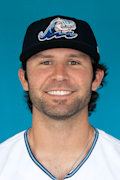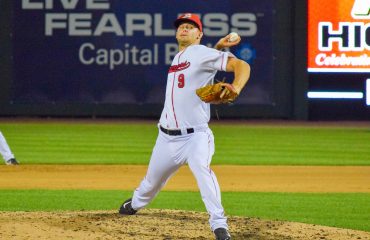Here’s a quick preview of three Atlantic League players that may be worth a look in the future or down the stretch if they find their way back into affiliated baseball.
 Jack Kenley, 2B, York Revolution
Jack Kenley, 2B, York Revolution
Age: 23
Height/Weight: 6’0, 185 lbs
Bats/Throws: L/R
Kenley is really the only interesting prospect left in the Atlantic League. After being selected in the eighth round of the 2019 MLB Draft by Detroit, he signed for $135,000 and forewent his senior season at the University of Arkansas. Kenley then began his pro career with a disappointing .214/.310/.359 slash line with 51 K’s in 170 PA across three lower levels of Detroit’s system. By doing so, he failed to back up his breakout collegiate campaign in 2019, where he slashed .311/.428/.553 with 13 HR. Notably, he posted a higher OPS that year than outfield teammate Heston Kjerstad (Orioles’ second overall pick in the 2019 MLB draft).
Kenley found himself released after a rough 16 games between Detroit’s High-A West Michigan and Double-A Erie this year. He was only able to muster a meager .336 OPS during his short 2021 affiliated tenure, striking out 15 times in 51 PA. He’s rebounded nicely so far in York though, where he’s slashing an impressive .344/.467/.557 in the hitter-friendly independent Atlantic League. An even more encouraging sign is the fact that he’s running a higher BB% (18.8%) than K% (16.5%) while tallying 17 extra-base hits in 170 PA. Kenley is also a full two years younger than any of the top 35 Atlantic League hitters by OPS.
The 2021 FanGraphs report on Kenley ranked him 31st in the Tigers’ farm system.
“There’s nothing new on Kenley, who was neither at the alt site nor instructs: Even on a loaded Arkansas team, Kenley stayed under the national scouting radar since he didn’t play much until his junior year, and was an infielder without much power who didn’t play shortstop. He shows 45 raw power in BP but has a flat swing plane that’s geared for line drives and contact. He seems like a candidate for a swing change, but could also carve out a role as a lefty-hitting, contact-oriented bench bat infielder along the lines of Tommy LaStella before he suddenly had power.”
The report on Kenley is a bit different than the 2021 FanGraphs’ one. Since his amateur days at Arkansas and his 2019 time in Detroit’s system, the swing has changed. He’s utilizing a different starting position with his hands, where he keeps them up higher and away from his body before his load. This has allowed him to get into a stronger hitting position and sink better into his hips. This has led him to incorporate more lift in his swing, which has led to more of an ability to access in-game power than before. Though the swing has more lift, it also has led to more top-hand rollovers when Kenley is unable to properly square up the baseball. Furthermore, I’ve seen the extra hand movement in Kenley’s swing lead him to foul off and get beat by outer-half fastballs. His hands sometimes appear out of sync with his body, likely because the positioning/movements are still relatively new to him. Although he occasionally toes the line between patient and passive, Kenley’s plate discipline has also been above-average during his Atlantic League stint.
Kenley has played almost exclusively at second base with York. He’ll likely end up as a 45 or 50 defender. Though, his footwork and approach on routine groundballs are a bit shaky and need improvement. I’ve seen him be solid around the bag on double plays and display decent range on diving plays, as well. He is athletic enough to potentially become a viable defender at other positions. A move to a corner spot, though, would raise the offensive bar he needs to clear to have any value. He’s also a 50 runner with good instincts that give him a boost as a baserunner.
It’s a bit concerning that a rebuilding organization gave up on him so quickly. However, the swing improvement and excellent Atlantic League performance make Kenley a young and intriguing independent league prospect. He doesn’t really have an elite carrying tool, but there’s a chance he develops enough as a hitter to end up with a spot on a major league bench.
Scott Shuman, RHP, Lancaster Barnstormers
Age: 33
Height/Weight: 6’3, 205 lbs
Originally drafted out of Auburn by the Tampa Bays in the 19th round of the 2009 MLB Draft, Shuman hasn’t pitched in affiliated baseball since 2013. Despite a K/9 north of 14 over 206 affiliated minor league innings, Shuman was released after three straight years with a ghastly BB/9 total above 10. After his release, Shuman has become a pitching nomad of sorts. He’s made stops in the Atlantic League with the Long Island Ducks, Lancaster Barnstormers, and now-defunct Bridgeport Bluefish. He made American Association stops with the Chicago Dogs and now-defunct Wichita Wingnuts. He’s also made foreign appearances in two different Mexican Leagues, spent two seasons with the Melbourne Aces in Australia, and even made a brief appearance in the Venezuelan Winter League.
Over the last few years, Shuman has become one of the more dominant arms in all of independent baseball. He’s spent his last four Atlantic League seasons with Lancaster, where he’s posted season ERA totals of 2.91 (2017), 0.98 (2018), 2.62 (2019), and 2.08 (2021). During that span, he nearly posted a season-long K/9 of 17 in 2018. Over his last 36 innings, Shuman has settled in around a 14 K/9. In 2021, he has posted a 2.30 FIP, while holding the highest CSW% (37.3%) in the Atlantic League by a wide margin. Shuman has always seemingly been denied another chance to return to affiliated baseball because of his erratic command. However, his BB/9 has improved and now hovers around 4 since the beginning of the 2019 Atlantic League season. Outside of a few short erratic stints in foreign leagues, Shuman has recently been able to showcase his dominant stuff, while showing an improved sense of command.
Shuman throws with a unique delivery that looks a bit like Pete Fairbanks’ motion. He throws with a bit of a lower arm slot than Fairbanks but utilizes similar movements in his delivery. His fastball routinely sits in the 93-96 mph range and on a few occasions has been more in the 95-98 mph range. I’ve seen him touch 99 mph once this season. Shuman’s primary off-speed offering is a slider that sits around 87-89 mph and possesses real wipeout movement that generates ugly swings and misses. He doesn’t land his slider in the zone too often. Instead, he mostly uses the pitch to get righties to chase down and away. He also sprinkles in a splitter, which sits in the 86-88 mph range. He tunnels the splitter well off of his fastball. Usually, he sets the pitch up with fastballs elevated in the zone early in the count before dropping the splitter later on.
Shuman’s pure stuff is impressive, especially for an independent league arm. His command has always held him back and has reared its ugly head during outings in the past. Though, in recent seasons, Shuman has been able to harness his command a bit, while still maintaining the same caliber of stuff. It’s unclear if Shuman will ever get another chance in affiliated baseball. If he does and the command doesn’t desert him again, he has the pure stuff to pitch in a big-league bullpen.
@scottshuman9 Been a long week but here’s some lighting bolts and an exploding slider for ya! @lancasterbarnstormers @mlb @milb @pitchingninja #baseball #pitching
@scottshuman9 Swing and misses…this is what I love about pitching.. sure I give up my fair share of nukes but man this is fun! #pitching #baseball #baseballtiktoks
Boog Powell, OF, Gastonia Honey Hunters
Age: 28
Height/Weight: 5’10, 200 lbs
Powell can be described as the kind of player you love to play with and hate to play against. He’s an on-base threat, who consistently puts together long, professional at-bats. He leads the league in doubles (23) and his 1.029 OPS ranks him eighth. Powell also plays a real center field and can go get it better than anyone else in the league. Back in 2017, he posted a 109 wRC+ in 135 PA at the major league level between Oakland and Seattle on his way to a 0.7 fWAR. He flopped in the majors in 2018, before rebounding in 2019 for an above-average offensive season at Triple-A in the Padres organization. He spent 2020 at the Reds’ alternate site and now finds himself in Gastonia.
Powell is likely still in the Atlantic League for two reasons. While he’s of major league caliber with his center-field defense and baserunning, he’s not quite quick enough to provide real value as a pinch-runner/defensive replacement. Secondly, he’s been plagued by off-field issues that might steer teams away from him. He’s been suspended multiple times for PED usage and required stitches after a winter ball altercation with teammate Dylan Cozens.
Despite the negatives, Powell would have a decent chance of filling in at the major league level and providing someone with a positive WAR right now. At the very least, he would be great outfield depth to have at Triple-A. He’s dominating the Atlantic League at the plate, has great baseball instincts, and possesses the skills that lower the offensive bar he needs to reach to have value.
